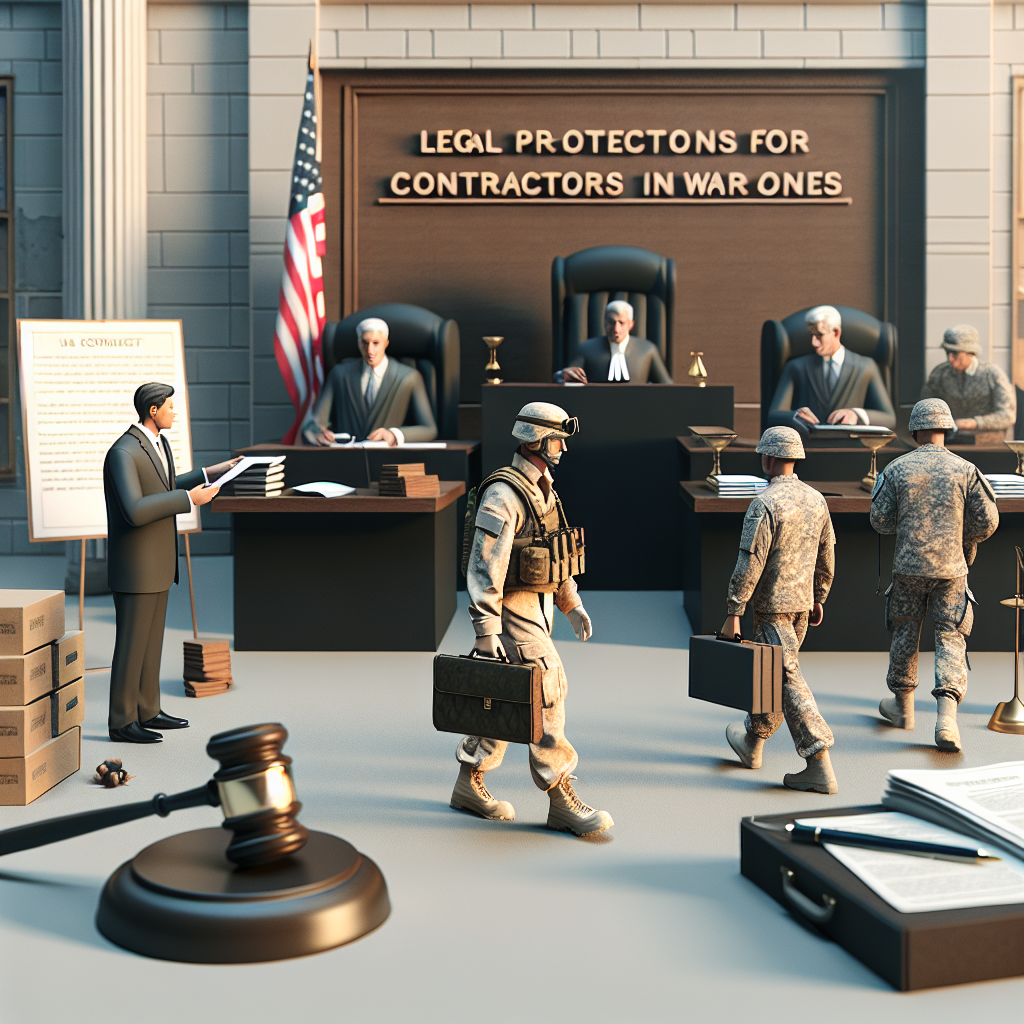The debate surrounding the legal protections afforded to military contractors has gained renewed attention following the recent Supreme Court arguments in the case of Hencely v. Fluor Corporation. The case centers on the implications of contractor liability for negligent actions in active war zones, particularly in light of a tragic suicide bombing at Bagram Air Force Base in Afghanistan. The court’s discussions highlighted a significant skepticism among justices regarding the extent of immunity that military contractors can claim when their actions contribute to disastrous outcomes.
The Background of the Case
The incident that sparked this legal battle involved a suicide bombing executed by an Afghan employee, which resulted in injuries to several individuals, including Winston Hencely. Hencely’s lawsuit against Fluor Corporation was predicated on the assertion that the company’s failure to adequately supervise the bomber led to the attack. However, the lower courts ruled in favor of Fluor by invoking a precedent set in the 1988 case of Boyle v. United Technologies Corp., which established certain protections for contractors engaged in military operations.
In the Boyle case, the Supreme Court determined that contractors could not be held liable under state law for actions taken while fulfilling their contractual obligations to the military. This ruling aimed to ensure that federal contractors were not hindered by state regulations that could conflict with their duties to the government. However, the applicability of Boyle has come under scrutiny in the context of Hencely’s case, particularly because the government had indicated that Fluor’s actions were not merely compliant with its directives but were, in fact, violations of established protocols.
Arguments Presented to the Court
Fluor’s defense hinged on the argument that the unique circumstances of a combat zone create an environment where state laws should not apply. The company posited that the federal interests in such areas should supersede any potential liability under state law. Justice Brett Kavanaugh appeared to show some openness to this line of reasoning, suggesting that the complexities of military operations might necessitate a different legal framework for contractors.
Conversely, several justices, including Elena Kagan and Sonia Sotomayor, expressed reservations about granting absolute immunity to contractors. They pointed out that the actions taken by Fluor were not only outside the bounds of its contractual obligations but also represented a breach of the military’s guidelines. Kagan articulated that the principle derived from Boyle implies contractor liability unless the military explicitly approved the conduct in question.
Implications of the Debate
This ongoing legal discourse raises significant questions about the balance between protecting military contractors and ensuring accountability for actions that can lead to catastrophic consequences. The court’s eventual ruling in this case could set a precedent that either fortifies or diminishes the protections currently available to contractors operating in war zones. As the justices deliberate, the ramifications of their decision will likely reverberate through both the legal and military communities.
The discussion also touches on broader themes within the realm of tort reform laws and the evolving nature of liability in complex operational environments. As courts navigate these intricate legal landscapes, the outcome of Hencely v. Fluor Corporation will be pivotal in defining the contours of contractor accountability.

| Case Name | Year | Significance |
|---|---|---|
| Hencely v. Fluor Corporation | 2023 | Debate over contractor liability in war zones |
| Boyle v. United Technologies Corp. | 1988 | Established contractor immunity under certain conditions |
As the justices continue to ponder the implications of their decision, the intersection of military operations, contractor responsibilities, and state law remains a critical area of legal scholarship and practical concern. The outcome could reshape the landscape of how contractors operate in conflict zones, potentially influencing future cases involving multidistrict litigation involving military contractors.
The recent oral arguments in the case of Hencely v. Fluor Corporation have sparked significant debate regarding the legal protections afforded to military contractors operating in active war zones. The case centers around a tragic suicide bombing at Bagram Air Base in Afghanistan, where the actions of an Afghan employee, employed by Fluor, resulted in injuries to several individuals, including Winston Hencely. This incident raises critical questions about the extent of immunity that military contractors can claim when their actions—or lack thereof—contribute to such catastrophic events.
Legal Precedents and Contractor Immunity
At the heart of the discussion is the 1988 Supreme Court decision in Boyle v. United Technologies Corp., which established a precedent for contractor immunity under certain conditions. In Boyle, the Court ruled that contractors could not be held liable under state law for design defects if they were acting in accordance with government specifications. However, the applicability of this precedent to the current case is contentious, particularly because the military’s conclusion indicated that Fluor’s negligence in supervising the bomber directly contributed to the attack. This divergence from the principles set forth in class action lawsuits complicates the argument for absolute immunity in this instance.
Justice Brett Kavanaugh’s inclination to uphold the argument that federal interests in a combat zone supersede state law reflects a broader perspective on military contractor operations. However, other justices, including Elena Kagan and Sonia Sotomayor, challenged this view by highlighting that Fluor’s conduct did not align with its contractual obligations. Kagan articulated that if the military did not specifically authorize the contractor’s actions, liability could still be imposed, thus creating a potential pathway for accountability.
The Distinction of Combat Zone Operations
The debate extends beyond mere legal interpretation; it encompasses the ethical implications of contractor conduct in war zones. The argument that military contractors should be granted immunity due to the unique nature of their operations raises concerns about accountability and the potential for negligence. As the justices deliberated, the emphasis on whether Fluor’s actions were in violation of its contract with the military became a pivotal point. This situation is starkly different from landmark court cases where contractors performed as per directives, shielding them from liability.

Furthermore, the implications of this case could set a significant precedent for future contractor liability in war zones. If the Court were to rule in favor of Fluor, it could create a legal environment where contractors operate without fear of repercussions for their actions, potentially leading to a culture of negligence. This scenario raises pressing questions about the balance between protecting contractors and ensuring that they adhere to the standards of care expected in high-stakes environments.
Implications for Future Cases
The outcome of Hencely v. Fluor Corporation will likely have lasting effects on the legal landscape surrounding military contractors. Should the Court lean towards affirming contractor immunity, it may embolden other contractors to prioritize operational mandates over safety protocols. However, if the justices decide to limit this immunity, it could pave the way for greater accountability in situations where contractor negligence has dire consequences.
As the legal community awaits the Court’s ruling, the discussions surrounding this case echo broader themes in tort law and the responsibilities of those engaged in military operations. The potential for liability in cases involving contractor misconduct could reshape the dynamics of military contracts and the expectations placed on those who serve in these critical roles. Notably, the ramifications may extend to other areas of litigation, such as talc litigation setbacks, where accountability is similarly contested.
The ongoing debates surrounding the legal protections afforded to military contractors in war zones have significant implications for accountability and oversight. In the recent argument concerning the case of Hencely v. Fluor Corporation, the Supreme Court grappled with the boundaries of contractor immunity, particularly in light of incidents that arise from negligence. The discussion highlighted the complexities involved in balancing national security interests with the necessity of holding contractors accountable for their actions, especially when those actions lead to tragic outcomes.
Legal Precedents and Their Implications
The case at hand draws heavily from the precedent set by the 1988 Supreme Court ruling in Boyle v. United Technologies Corp., which established that military contractors could be granted immunity from state law claims if their actions were in line with government directives. However, the current case presents a stark contrast, as Fluor’s alleged negligence—specifically, its failure to supervise an Afghan employee who perpetrated a suicide bombing—raises questions about the applicability of Boyle’s protections. The crux of the debate lies in whether the government’s determination that Fluor violated its own operational guidelines negates the immunity previously afforded under Boyle.

Justice Elena Kagan’s remarks during the hearings were particularly revealing; she articulated a perspective that suggests contractors should be held liable when their actions deviate from the specific directives issued by the military. This interpretation implies that even in war zones, contractors cannot operate with absolute immunity if their conduct is found to be negligent or in violation of established military protocols. Such a stance could lead to a reevaluation of how military contractors are managed and monitored in active combat situations.
Federal Interests vs. State Liability
Fluor’s legal team argued that the unique circumstances of combat zones necessitate a broader interpretation of federal interests, positing that these interests should override any potential state law claims. This argument, while compelling to some justices, faced skepticism from others who underscored the need for accountability. Justice Brett Kavanaugh appeared to be open to the notion that federal interests could provide a shield against state liabilities, yet the majority of the bench seemed unconvinced, emphasizing that accountability should not be sacrificed in the name of federal authority.
Furthermore, Justice Sonia Sotomayor raised critical points about the implications of granting blanket immunity to contractors. By suggesting that the contractor’s actions must align with the military’s expectations, she illustrated the potential risks of allowing contractors to operate without sufficient oversight. This line of reasoning indicates a shift towards greater scrutiny of contractor behavior in war zones, which could lead to more stringent regulations and accountability standards in the future.
The Future of Contractor Accountability
The implications of this case go beyond the immediate legal questions; they touch on broader themes of governance, accountability, and the role of private contractors in military operations. As military engagements evolve and the nature of warfare changes, the legal frameworks governing contractor conduct must also adapt. The outcome of Hencely v. Fluor Corporation could set a significant precedent for how military contractors are held accountable for their actions, particularly in high-stakes environments.
Legal experts and policymakers alike are watching closely, as the decision may influence future contracts and operational guidelines for military contractors. The potential for increased liability could lead to a reassessment of how contractors approach their responsibilities in combat zones. For those interested in understanding the legal risks associated with contractor operations, exploring resources on legal risks social media can provide valuable insights into the broader context of contractor accountability.